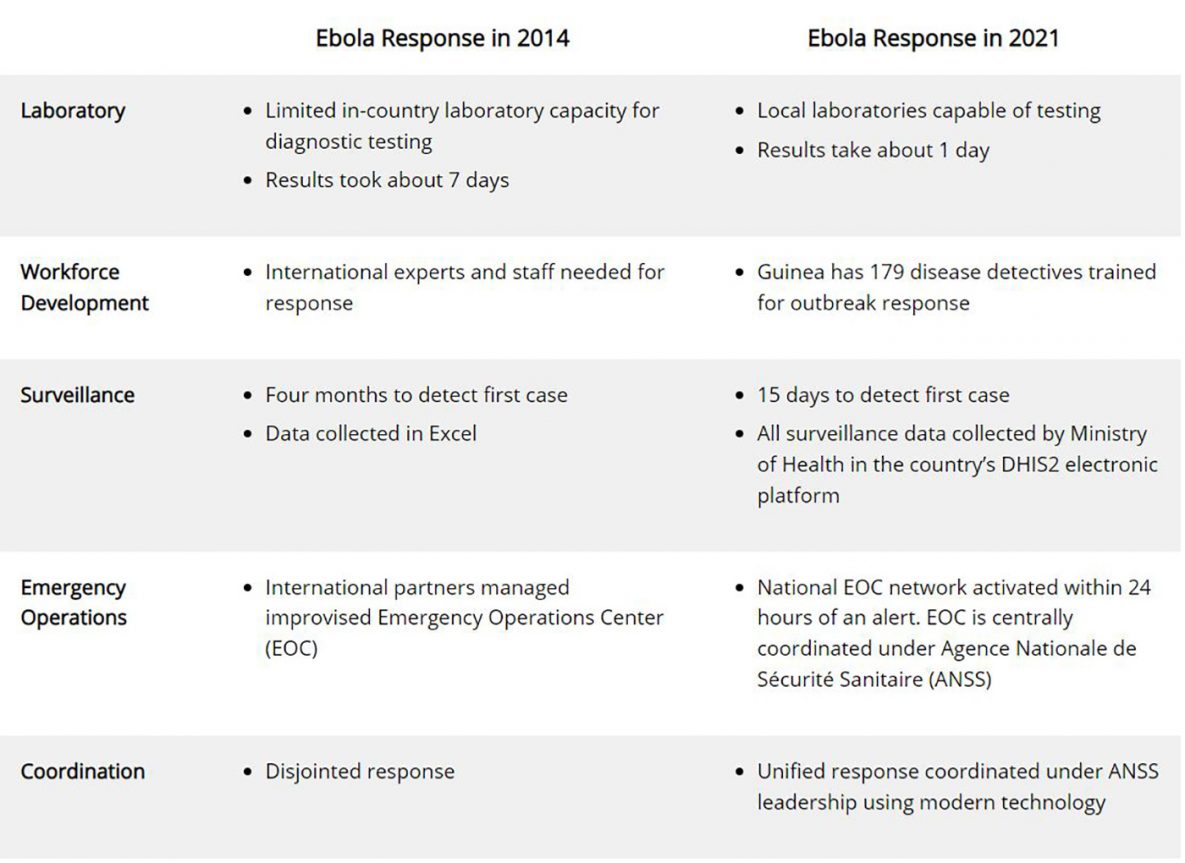Rapid Response to Outbreaks Through CDC’s Investment in Global Health Security
Outbreaks around the world have been detected and stopped more rapidly than ever before through CDC’s investment in global health security.
CDC’s global health security investments in Guinea in four essential areas—laboratory, workforce development, surveillance, and emergency preparedness and response—played a key role in the country detecting and responding to the 2021 Ebola outbreak. Collaboration and support from CDC and partners in Guinea helped end the 2021 Ebola outbreak in just four months with 23 cases and 12 deaths. This outbreak was contained to the N’Zérékoré Prefecture in Guinea. In comparison, an Ebola outbreak that lasted from 2014–2016 resulted in 3,800 people becoming infected and more than 2,500 people dying. That Ebola outbreak spread to 10 countries worldwide including the United States.
Laboratory testing became available in the country, and lab results improved from taking seven days to taking about one day. Surveillance investments helped detect the first case in 15 days instead of four months and led to use of an online system for reporting cases which wasn’t available during the prior outbreak. The trained workforce to respond to outbreaks went from inadequate to at least 179 disease detectives. The country now has a national Emergency Operations Center (EOC) network that can be activated within 24 hours of an alert rather than using a disjointed response with an improvised EOC. These investments saved lives and will continue to improve response to disease in the future.

Additional Examples of Rapid Response Through CDC’s Investment:
EVD Preparedness Pays Off
Ugandans knew they had to get ready for the worst when neighboring Democratic Republic of Congo (DRC) reported a new EVD outbreak on August 1, 2018. Uganda’s Ministry of Health (MOH) activated the Public Health Emergency Operations Centre (PHEOC) and began preparedness activities. CDC-supported global health security investments and efforts in Uganda have dramatically helped the country reduce the time it takes to detect and respond to outbreaks. CDC has been supporting the MOH and its implementing partner, the Infectious Diseases Institute (IDI), to map routes traveled between DRC and Uganda, and points of interest within Uganda visited by Congolese, including healthcare facilities like Kagando Hospital. Additionally, in April 2019, the MOH, CDC, and other partners held a nationwide EVD outbreak simulation exercise. When the first case of EVD associated with the recent DRC outbreak was detected in Uganda in June 2019, the MOH was able to stand up a response that held the number of confirmed cases to three – all of which were imported from DRC had not resulted from circulation within Uganda.
Event-based Surveillance in Burkina Faso
In 2017, CDC launched an event-based surveillance (EBS) program in Burkina Faso that supported three district health teams, 210 assistant nurses and chief nurses, and 935 community health workers. The EBS system was put to the test when more than 200 donkeys died of unexplained illness across the country between late 2018 and early 2019. Through effective field investigations, a team of key partners – including the Ministry of Health, the Ministry of Animal and Fisheries Resources and CDC – determined two different causes for the unexplained illnesses. One cause was strangles, an infectious respiratory disease of donkeys, horses, and mules, and the other was anthrax, a serious bacterial disease that can cause death in humans. Burkina Faso’s rapid response introduced control measures that prevented the loss of more livestock and the spread of disease from animal to human.
Rapid Response to Outbreaks Through CDC’s Investment in Global Health Security
